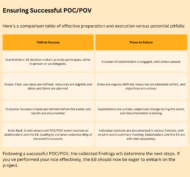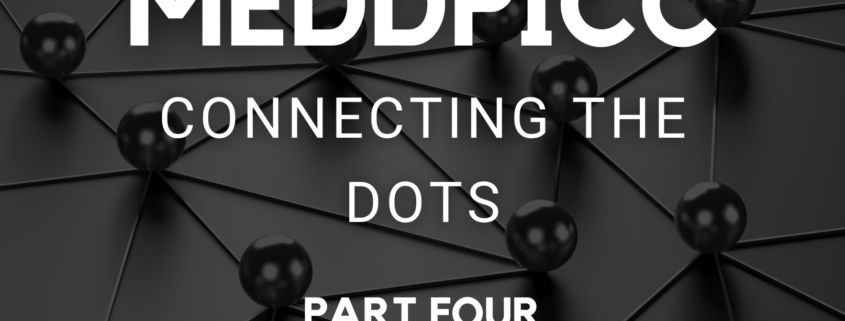MEDDPICC: Connecting The Dots – PART FOUR
Securing Buy-In from Stakeholders in the MEDDPICC Journey
In the previous episodes of our MEDDPICC journey we delved into critical elements such as identifying pain points, addressing broader business issues, nurturing a champion with a vested interest, and ultimately reaching the all-important Economic Buyer (EB). The EB, recognizing the significance of your solution, shares their perspective, and is willing to endorse your campaign.
Understanding the Challenge
Now, in this part, we explore the challenging and often arduous process of securing a buying decision. You might be wondering why this stage is particularly demanding. It’s because Economic Buyers (EBs) are reluctant to greenlight purchasing decisions without obtaining buy-in from stakeholders at all levels. The return on investment (ROI), closely tied to value realization, relies heavily on these stakeholders supporting and driving the project to unlock the value of your proposed solution.
According to the CEB B2B buyers’ updated research from 2021, an average of six stakeholders need to approve a buying decision. These stakeholders span various departments and exhibit different personalities and attitudes. Some are enthusiastic about change and new ideas driven by business opportunities. Others act as blockers and defenders of the status quo, often residing in overloaded operations, implementation, or IT departments. This complexity presents a substantial challenge for any organization.
The salesperson’s dilemma arising from these facts is corroborated by Forrester’s 2019 research, which stated that 60% of opportunities fail to close due to a “no decision” outcome.
Guiding the Decision-Making Process
So, how can you assist your client in making a decision? First and foremost, you need to involve as many of “the six”or more decision makers we mentioned above. Typically, the decision-making process involves two to three key areas: defining the solution fit, securing funding, and formalizing paperwork and final approvals. In many instances, it’s prudent to identify and cultivate champions for each of these areas, such as a
- Solutions champion,
- Business or Budget champion (often the EB or lead business owner), and a
- paper process champion, frequently found in the sourcing or procurement department.
Utilizing the MEDDPICC Framework
The good news is that MEDDPICC offers a comprehensive framework to guide salespeople in supporting their clients. This framework draws from mapping Pain, Metrics, Decision Criteria, Competition, Decision Process, and the Economic Buyer.
Determining the answers to 3 WHYs
Why do anything?
This is typically the initial phase of the decision process. The information you’ve gathered, including quantified pain points supported by solid metrics that emphasize business urgency and the consequences of inaction, will help answer the stakeholders’ crucial question:
“Why do we need to take action and what happens if we don’t?
“Why should they choose your offering?”
At this stage, the client’s required capabilities and decision criteria, which you’ve likely collected from various stakeholders, should form a solid decision-making foundation. Ideally, these criteria should highlight your unique differentiators.
Documenting this decision criteria is vital, whether in a formal Request for Proposal (RFP) document or an informal presentation, to establish a shared decision framework among stakeholders. We strongly recommend documenting the “why act” and “why your offering” in your customer’s language to serve as an elevator pitch, a basis for discussions, and a repository of shared understanding.
Client Requests for Proof
Clients often request proof of your ability to meet their needs, often through events like a Proof of Concept (POC) or Proof of Value (POV). These events can take various forms, from formal events to workshops. They can be powerful if well-prepared but may lead to confusion and indecision if not. We recommend securing the Economic Buyer’s mandatory approval and engagement prior to the event to ensure the dedication, resources, and focus from the client’s team needed for a successful event.

Don’t forget Addressing Competition
However, competition may still be in the picture.
You must address the fundamental question: “Who is the best partner to help us solve this problem?” Make sure you know who you compete against, set traps to neutralize them and position your unique differentiators… Read more here.
Think about your clients success
In addition to your compelling offer and unique differentiators, it’s crucial to reassure your client about how your team will ensure the successful realization of the project.
Ideally, you should outline key milestones, potential risks, and how to mitigate them along the way. In this process, leveraging your champion and assembling the right representatives from the business, project, and operations teams is key to ensuring a smooth transition.
With the first part of the decision made, you’re well on your way to obtaining budget approval and successfully contracting with the client, which we’ll explore in our upcoming paper process article.
Stay tuned for our next part, where we’ll delve into:
- The route to budget
- The route to the paper process







Leave a Reply
Want to join the discussion?Feel free to contribute!